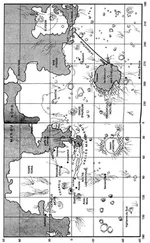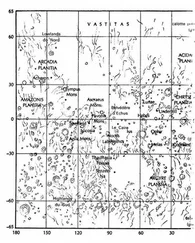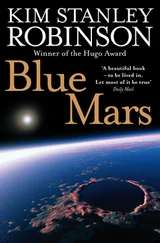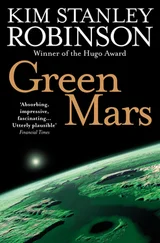Kim Robinson - Blue Mars
Здесь есть возможность читать онлайн «Kim Robinson - Blue Mars» — ознакомительный отрывок электронной книги совершенно бесплатно, а после прочтения отрывка купить полную версию. В некоторых случаях можно слушать аудио, скачать через торрент в формате fb2 и присутствует краткое содержание. Год выпуска: 1996, ISBN: 1996, Издательство: Spectra/Bantam Dell/Random House, Жанр: Космическая фантастика, на английском языке. Описание произведения, (предисловие) а так же отзывы посетителей доступны на портале библиотеки ЛибКат.
- Название:Blue Mars
- Автор:
- Издательство:Spectra/Bantam Dell/Random House
- Жанр:
- Год:1996
- ISBN:0-553-10144-7
- Рейтинг книги:3 / 5. Голосов: 1
-
Избранное:Добавить в избранное
- Отзывы:
-
Ваша оценка:
- 60
- 1
- 2
- 3
- 4
- 5
Blue Mars: краткое содержание, описание и аннотация
Предлагаем к чтению аннотацию, описание, краткое содержание или предисловие (зависит от того, что написал сам автор книги «Blue Mars»). Если вы не нашли необходимую информацию о книге — напишите в комментариях, мы постараемся отыскать её.
Green Mars
The Martian Chronicles
Dune
Piblishers Weekly st
Blue Mars — читать онлайн ознакомительный отрывок
Ниже представлен текст книги, разбитый по страницам. Система сохранения места последней прочитанной страницы, позволяет с удобством читать онлайн бесплатно книгу «Blue Mars», без необходимости каждый раз заново искать на чём Вы остановились. Поставьте закладку, и сможете в любой момент перейти на страницу, на которой закончили чтение.
Интервал:
Закладка:
“Do you think this takeover of Clarke is serious?” Ann asked one night as they were retiring to their hulls.
“It’s hard to say. Sometimes I think it must be a threatening gesture only, because if it’s serious it would be so — unintelligent. They must know that Clarke is very vulnerable to — removal from the scene.”
“Kasei and Dao didn’t find it that easy to remove.”
“No, but — ” Sax did not want to say that their attempt had been botched, but he was afraid that she would read the comment out of his silence. “We in Da Vinci set up an X-ray laser complex in Arsia Mons caldera, buried behind a rock curtain in the north wall, and if we set it off the cable will be melted right at about the areosynchronous point. There isn’t a defensive system that could stop it.”
Ann stared at him; he shrugged. He wasn’t personally responsible for Da Vinci actions, no matter what people thought.
“But bringing down the cable,” she said, and shook her head. “It would kill a lot of people.”
Sax remembered how Peter had survived the fall of the first cable, by jumping out into space. Rescued by chance. Perhaps Ann was less likely to write off the lives that would inevitably be lost. “It’s true,” he said. “It isn’t a good solution. But it could be done, and I would think the Terrans know that.”
“So it may just be a threat.”
“Yes. Unless they’re prepared to go further.”
North of the Oxia archipelago they passed McLaughlin Bay, the eastern side of a drowned crater. North again was Mawrth Point, and behind it the inlet to Mawrth Fjord, one of the narrowest and longest fjords of all. It was a matter of constant tacking to sail up it, pushed this way and that by tricky winds, swirling between steep convolute walls; but Sax did it anyway, because it was a pretty fjord, at the bottom of a very deep and narrow outbreak channel, widening as one sailed farther into it; and beyond and above the end of the water, the rock-floored canyon continued inland for as far as one could see, and many kilometers beyond that. He hoped to show Ann that the existence of the fjords did not necessarily mean the drowning of all the outbreak channels; Ares and Kasei also retained very long canyons above sea level, and Al-Qahira and Ma’adim as well. But he said nothing of this, and Ann made no comment.
After the maneuvering in Mawrth, he sailed them almost directly west. To get out of the Chryse Gulf into the Acidalia region of the North Sea, it was necessary to work around a long arm of land called the Sinai Peninsula, sticking out into the ocean from the west side of Arabia Terra. The strait beyond it connecting Chryse Gulf with the North Sea was 500 kilometers wide; but it would have been 1,500 kilometers wide if it were not for the Sinai Peninsula.
So they sailed west into the wind, day after day, talking or not talking. Many times they came back to what it might mean to be brown. “Perhaps the combination should be called blue,” Ann said one evening, looking over the side at the water. “Brown isn’t very attractive, and it reeks of compromise. Maybe we should be thinking of something entirely new.”
“Maybe we should.”
At night after dinner, and some time looking at the stars swimming over the sloppy sea surface, they said good night, and Sax retired to the starboard hull cabin, Ann to the port; and the AI sailed them slowly through the night, dodging the occasional icebergs that began to appear at this latitude, pushed into the gulf from the North Sea. It was quite pleasant.
One morning Sax woke early, stirred by a strong swell under the hull, which pitched his narrow bed up and down in a way that his dreaming mind had interpreted as a giant pendulum, swinging them this way and that. He dressed with some difficulty and went abovedeck, and Ann, standing at the shrouds, called out, “It seems the groundswell and the windchop are in a positive interference pattern.”
“Are they!” He tried to join her, and was slammed down into a cockpit seat by a sudden rise of the boat. “Ah!”
She laughed. He grabbed the cockpit handrail, pulled himself up to her side. He saw immediately what she meant; the wind was strong, perhaps sixty-five kilometers per hour, and the whine in the boat’s minimal rigging was loud and sustained. There were whitecaps everywhere on the blue sea, and the sound of the wind coursing through all that broken water was very unlike what it would be pouring over rock — there it would be a high keening shriek — here, among the trillions of bursting bubbles, it was a deep solid roar. Every wave was whitecapped, and the great hills of the ground swells were obscured by foam flying off the crests and rolling in the troughs. The sky was a dirty opaque raw umber, very ominous looking, the sun a dim old coin, everything else dark, as if in shadow, though there were no clouds. Fines in the air: a dust storm. And now the waves were picking up, so that they spent many long seconds shooting up the side of one, then almost as many schussing down into the trough of the next one. Up and down in a long rhythm. The positive interference Ann had spoken of made some waves doubly big. The water not foaming was turning the color of the sky, brownish and dull, dark, though there was still not a cloud to be seen — only this ominous color of the sky; not the old pink, but more like the dust-choked air of the Great Storm. The whitecaps ceased in their area and the sound of water against the boat grew louder, a slushy rumble; the sea here was coated with frazil ice, or the thicker elastic layer of ice crystals called nilas. Then the whitecaps returned, twice as thick as before.
Sax climbed down into the cockpit and checked the weather report on the AI. A katabatic wind was pouring down Kasei Vallis and onto Chryse Gulf. A howler, as the Kasei fliers would say. The AI should have warned them.
732 Blue Mars
But like many katabatic storms it had come up in an hour, and was still a fairly local phenomenon. Yet strong for all that; the boat was on a roller-coaster ride, shimmying under hammer blows of air as it shot up and down on the huge groundswell. To the side the waves looked like they were being knocked over by the wind, but the boat’s skittering flights up and down showed that they underlay the flying foam as big as ever. Overhead the mast sail had contracted almost to a pole, in the shape of an aerodynamic foil. Sax leaned over to check the AI more closely; the volume knob on the beeper was turned all the way down. So perhaps it had tried to warn them after all.
A squall at sea; they came up fast. Horizons only four kilometers away didn’t help matters; and the winds on Mars had never slowed down much, in all the years of thickening. Underfoot the boat shuddered as it smashed through some invisible fragments of ice. Brash ice now, it appeared, or the broken pancake ice of a sea surface that had been about to freeze over in the night; difficult to spot in all the flying foam. Occasionally he felt the impact of a larger chunk, bergy bergs as sailors called them. These had come through the Chryse Strait on a current from the north; now they were being pushed against the lee shore of the southern side of the Sinai Peninsula. As the boat was too, for that matter.
They were forced to cover the cockpit with its clear shell, rolling up out of the decking and over to the other side. Under its waterproof cover they were immediately warmer, which was a comfort. It was going to be a true howler, Kasei Vallis serving as a conduit for an extremely powerful blast of air; the AI listed wind speeds at Santorini Island fluctuating between 180 and 220 kilometers an hour, winds which would not diminish much in speed as they crossed the gulf. Certainly it was still a very strong wind, 160 kilometers an hour at the masthead; the surface of the water was disintegrating now, crests flattened by gusts, torn apart. The ship was shutting down in response to all that, mast retracting, cockpit covered, hatches battening; then the sea anchor went out, a tube of material like a wind sock, dragging underwater upwind of them, slowing their drift to leeward, and mitigating the jarring impacts against small icebergs that were becoming more frequent as they all clustered against the lee shore. Now with the sea anchor in place, it was the brash ice and bergy bergs that were floating downwind faster than they were, and knocking against the windward hull, even as the leeward hull still slammed against a thickening ice mass. Both hulls were mostly underwater; in effect the boat was becoming a kind of submarine, lying at the surface and just under it. The strength of the materials of the boat could sustain any shock that even a howler and a lee shore of icebergs could deliver; indeed they could sustain forces several magnitudes stronger. But the weak point, as Sax reflected as he was thrown hard against his seat belt and shoulder harness, holding grimly to the tiller and his seatback, was their bodies. The catamaran lifted on a swell, dropped with a sickening swoop, crashed to a halt against a big berg; and he slammed breathlessly into the restraints. It seemed they might be in danger of being shaken to death, an unpleasant way to go, as he was beginning to understand. Internal organs damaged by seat belts; but if they freed themselves they would be flung around the cockpit, into each other or into something sharp, until something broke or burst. No. It was not a tenable situation. Possibly the restraints he had seen on his bed’s frame would be gentler, but the decelerations when the boat struck the ice mass were so abrupt that he doubted being horizontal would help much.
Читать дальшеИнтервал:
Закладка:
Похожие книги на «Blue Mars»
Представляем Вашему вниманию похожие книги на «Blue Mars» списком для выбора. Мы отобрали схожую по названию и смыслу литературу в надежде предоставить читателям больше вариантов отыскать новые, интересные, ещё непрочитанные произведения.
Обсуждение, отзывы о книге «Blue Mars» и просто собственные мнения читателей. Оставьте ваши комментарии, напишите, что Вы думаете о произведении, его смысле или главных героях. Укажите что конкретно понравилось, а что нет, и почему Вы так считаете.












